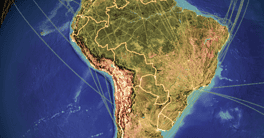Railway development in Africa as a path to economic growth is attracting capital and government support.
Twitter posts aren’t the most reliable news sources, but they can indicate which way the wind is blowing. Take this recent tweet: “In the next 10-20 years it might be possible to travel from Mombasa, Kenya to Juba, South Sudan, by rail.”
Nothing like this trip is currently possible, and to make it so would require a combination of institutional and commercial funding, agreements between regional governments, and resolution of cross-border policy differences. But the tweet underscores aspirations for Africa’s rail transportation—and economic growth—that are moving closer to reality. Most African countries are planning to build a new railway or revamp an old colonial railway—projects whose costs range from around $4 billion to $8 billion. But such infrastructure supports growth and development of the nation as a whole. A new rail project can add a full percentage point to a country’s GDP and tens of thousands of jobs.
East African nations are working on several standard-gauge railway projects designed to loop from Tanzania through Rwanda to Uganda, connecting with the Kenyan road that starts in Mombasa and runs to Nairobi, says Melissa Cook, founder of African Sunrise Partners.
The project of putting rail along the Kenyan road, including equipment, rolling stock and operations, was awarded to Chinese firms on a turnkey basis. The economic benefits of the first leg, officially inaugurated in May 2017, include expediting the movement of manufactured and agricultural goods to and from Mombasa and putting new muscle behind Kenya’s emphasis on imports and exports. “Before the launch of the first leg, all goods went by truck, which was inefficient and costly,” Cook notes.
Railroad development and redevelopment in Africa is just one facet of the continent’s efforts to improve infrastructure, says Corti Paul Lakuma, economist and research fellow at the Economic Policy Research Centre in Uganda. “Infrastructure in Africa is not just about railways. It includes the roads and energy infrastructure,” he says.
Moreover, while the anticipated economic benefits of new railways are enormous, every nation does not prioritize them equally. “It’s not a whole-Africa thing,” Lakuma says. Railways are most important to Ethiopia, Kenya, Uganda, Tanzania, Rwanda, Nigeria and Morocco but less imperative elsewhere. Priorities vary even within these countries and are affected by the level and type of economic activity, political considerations, government priorities and availability of finance. Rail is a major priority in Kenya, but upgrading roads has a greater urgency in Uganda, while improving seaports is considered significantly more vital in neighboring Tanzania.
Most new railroads are built in standard gauge, which has approximately 4 feet 8.5 inches, or 1.435 meters, between the inside of the tracks. African narrow-gauge railways, left over from the colonial era, tend to have either 1 meter or 1.067 meter gaps. Where possible, authorities are trying to rehabilitate these railways rather than build new ones from scratch. Considerations include regional connectivity and availability of rolling stock for different gauges.
In the narrow-gauge category, a consortium in Nigeria, led by General Electric and including SinoHydro (a Chinese construction services corporation), Transnet (a transportation and logistics infrastructure management firm) and APM Terminals (a port and terminal company) won approval for a project in April of this year. They will be rehabilitating and operating an existing rail line from the port of Lagos, Nigeria’s financial and commercial hub, to the agricultural regions of Kano and Kaduna, says Cook.
When completed, this railway will ship agricultural inputs, such as fertilizer, to the north and move agricultural products to market, such as cattle and vegetables, to Lagos. The refurbished line is expected to help boost the agricultural sector and create new jobs. The exact timing remains unclear, as GE recently sold its transportation business, but the other partners are expected to keep the project going. “It is still very much a live project but has not yet started,” says Cook.



